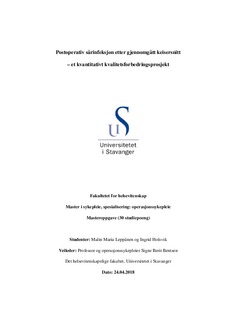| dc.contributor.advisor | Bentsen, Signe Berit | |
| dc.contributor.author | Holsvik, Ingrid | |
| dc.contributor.author | Leppänen, Malin Maria | |
| dc.date.accessioned | 2018-08-10T12:53:43Z | |
| dc.date.available | 2018-08-10T12:53:43Z | |
| dc.date.issued | 2018-04 | |
| dc.identifier.uri | http://hdl.handle.net/11250/2557565 | |
| dc.description | Master's thesis in Nursing science | nb_NO |
| dc.description.abstract | Formålet med dette kvalitetsforbedringsprosjektet er å kartlegge forekomsten av postoperative sårinfeksjoner hos kvinner som har gjennomgått keisersnitt i perioden september 2012 til august 2017 samt å undersøke hvilke faktorer som øker risikoen for at postoperative sårinfeksjoner oppstår. Prosjektet bruker data fra et utvalgt sykehus i Norge fra Folkehelseinstituttets NOIS-POSI og skal bidra til å belyse operasjonssykepleiers ansvars- og funksjonsområde i det forebyggende arbeidet av infeksjoner ved keisersnitt. Resultatene kan bidra til forbedring av prosedyrene ved sykehuset, slik at antall sykehusinfeksjoner reduseres og gi pasientene et tryggere pasientforløp.
Kvalitetsforbedringsprosjektet undersøker sammenhengen mellom postoperativ sårinfeksjon og alder, operasjonsdato, operasjonsvarighet, utskrivingsdato, sårkontaminasjon, ASA klassifikasjon, risikopoeng, perioperativ antibiotikaprofylakse, elektivt inngrep, akutt inngrep samt infeksjonsdato. Prosjektet belyser også hvilken type infeksjon som forekommer og hvor mange som må reopereres grunnet infeksjon. For å besvare problemstillingene, er det utført en registerbasert kohortstudie. Prosjektet er retrospektivt og tar i bruk prospektive data. Analysen av data ble gjort i SPSS og resultatene avdekket at det var statistisk signifikant sammenheng mellom operasjonsvarighet-, liggedøgn-, grad av sårkontaminasjon-, risikopoeng- og postoperativ sårinfeksjon.
Et lokalt utvalg gir ikke prosjektet generaliserbare resultater, men anses å være overførbare som følge av sammenlignbare forhold i helsevesenet nasjonalt. Prosjektet konkluderer med at det er viktig for operasjonssykepleieren å følge sin ansvars- og funksjonsbeskrivelse nøye og at det kirurgiske teamet sammen innhenter nødvendig informasjon for å avdekke eventuelle risikofaktorer for den individuelle pasienten. Dette kan redusere risikoen for postoperativ sårinfeksjon da operasjonssykepleier og teamet får en økt bevissthet om de predisponerende risikofaktorene som er identifisert i prosjektet. | nb_NO |
| dc.description.abstract | The aim of this quality-improvement project is to map the frequency of surgical site infections (SSI) with women who has undergone caesarean section within the timeframe of September 2012 to August 2017, as well as investigate which factors increase the risk for developing SSI. The project uses data from a chosen hospital in Norway, from Folkehelseinstituttets NOIS-POSI and contributes by showing the theatre nurses responsibility- and function description and its importance in preventing infections after a caesarean section. The results of the project can help improve the procedures at the hospital, to reduce the number of hospital infections and give better and safer patient care.
This project investigates if there is a link between surgical site infection and age, surgery date, duration of surgery, date of discharge, wound contamination, ASA-classification, risk points, perioperative antibioticprofylaxis, planned surgery and date of infection. The project also considers which kind of infection is most common and how many patients need to re-operate because of infection. The project is a register-based cohort-study and applies retrospective data, giving prospective results. The analysis is done by SPSS and the results showed a significant link between duration of surgery, postoperative days in hospital, wound contamination classification, risk points and SSI.
A local selection will not give results that can be generalized to the national population, but the project is transferable as the national healthcare system is homogenous. The project concludes that the theatre nurse must follow his/her responsibility- and function description and that the team has a joint responsibility to gather information and reveal possible risk factors with the individual patient. This provides an increased awareness around the predisposing risk factors revealed in this project for the theatre nurse and the team, potentially reducing the risk of developing SSI. | |
| dc.language.iso | nob | nb_NO |
| dc.publisher | University of Stavanger, Norway | nb_NO |
| dc.relation.ispartofseries | Masteroppgave/UIS-HV/2018; | |
| dc.rights | Navngivelse 4.0 Internasjonal | * |
| dc.rights.uri | http://creativecommons.org/licenses/by/4.0/deed.no | * |
| dc.subject | helse- og sosialfag | nb_NO |
| dc.subject | sykepleie | nb_NO |
| dc.subject | keisersnitt | nb_NO |
| dc.subject | operasjonssykepleie | nb_NO |
| dc.subject | postoperativ sårinfeksjon | nb_NO |
| dc.title | Postoperativ sårinfeksjon etter gjennomgått keisersnitt - et kvantitativt kvalitetsforbedringsprosjekt | nb_NO |
| dc.type | Master thesis | nb_NO |
| dc.subject.nsi | VDP::Medical disciplines: 700::Health sciences: 800::Nursing science: 808 | nb_NO |

